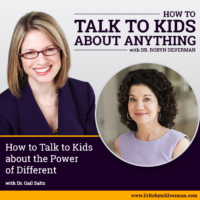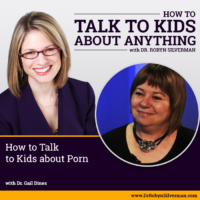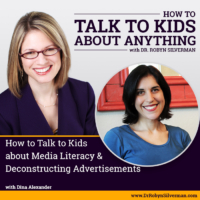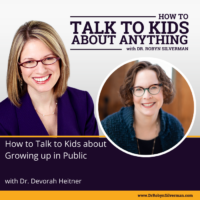Podcast: Play in new window | Download
Subscribe: Apple Podcasts | RSS | More
How to Talk to Kids about the Power of Different
This podcast will focus on mental disorders and diagnoses stem from a difference in wiring in the brain—and that these differences, while providing some challenges also often come with amazing gifts!
Special Guest: Dr. Gail Saltz
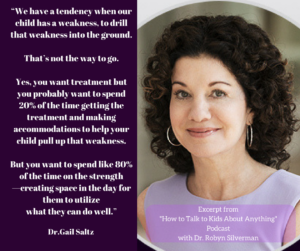 Every parent wants his or her child to be happy and successful. As parents, we learn from many books, experts, our own parents that there is a formula for this—they get enough sleep, we feed them right, we send them to school, give them love and boundaries, make sure they do their homework, we put them in the right sports, get them involved with enrichment activities—the brain and body develops and our child will be successful. Of course, in practice, this is often not such a clear-cut picture.
Every parent wants his or her child to be happy and successful. As parents, we learn from many books, experts, our own parents that there is a formula for this—they get enough sleep, we feed them right, we send them to school, give them love and boundaries, make sure they do their homework, we put them in the right sports, get them involved with enrichment activities—the brain and body develops and our child will be successful. Of course, in practice, this is often not such a clear-cut picture.
No child is the same as another. No brain is the same as another. And sometimes, when children don’t seem to be following the preconceived pattern that we expected, that we learned about, maybe that we hoped for, we might wonder how our child, who is different from the norm could become happy and successful. It turns out, as some have already discovered, that there is a power in being different and as parents, we can help cultivate, inspire and build upon that difference and that’s where the magic can happen. What magic you might wonder? What is the power of different? That’s why we are privileged to have our amazing guest, Dr. Gail Saltz, for today’s podcast episode.
Important Messages:

- There is no “normal” brain. Every brain is different. People tend to hear about diagnoses…but the diagnoses themselves are not what the clinicians are treating. They are treating symptoms. These symptoms arise because of some difference in wiring in the brain.
- Many parents miss and excuse the brain problems—but when we wait too long to treat mental health issues, children can get derailed by them.
- In youth, the brain is very plastic- so treat the symptoms so you can put the child on their normal developmental track and save them a great deal of suffering.
- Sometimes our own fears and judgments are projected onto others when it’s not always reality.
- ADD/ADHD is not an inability to focus- there is a faulty switch—and actually, kids can hyper focus when something is very interesting to them. The data show kids with ADD/ADHD can demonstrate the strength of creativity, out-of-the-box thoughts and originality. We need to treat these kids so that they can use their strengths.
- The data show that a disproportionate number of CEOs have ADD/ADHD. They are out of the box thinkers that get things done. They have high energy with an ability to spot connections and analogies that others often don’t.
- Check out the U shaped curve conversation at minute 20: If you have an overwhelming anxiety disorder, high levels of anxiety can flush out anything you might get out of it. At lower levels of anxiety things like an incredible diligence, attention to detail, hyper vigilance- these kids and adults can be incredibly sensitive to other people’s emotional states and read what is going on.
- High intelligence has often been co-evolved with worry.
- Frequency and interruption in functionality are tip-offs that something is going on and your child may need professional help.
- Why it’s necessary to expose your children to all different opportunities to see what gifts they have.
- How to talk to your child’s teacher about their strengths and how they can use them to put a new spin on school projects.
- Make sure your child is spending time doing the things that they have strengths in—to build them up (not just the areas in which they struggle).
- How to talk to your child who has a brain difference about that brain difference.
- How to use stories about amazing people who have brain differences who have found incredible gifts in their challenges.
Notable Quotables:
- “What is becoming apparent…is that people have incredible differences between their brains. The idea that there is a normal brain and an abnormal brain is not a reasonable way to think of things. “
- “If you are struggling with symptoms, it’s probably going to turn out to be that there is some difference in [brain] wiring that is leading to those symptoms but at the same time what ever difference in connectivity is there, also often comes with a very particular strength.”
- “If your child does present with a symptom, what you want to do is treat that symptom because you will put that child back on their normal developmental track and save them a lot of suffering.”
- “The difference in [your children’s] wiring probably means they have a very particular strength. Maybe even the kind of ability that can set them on the path to huge success. So you want to spend some of the time with your children, not just helping them with what isn’t working but playing to that area where they have the strength- hone that and use that to groom their own self esteem and their own abilities.”
- “Judgments and stigma pervades. So may are quietly judging yourselves, your own child, someone else’s child. If we can come together and acknowledge that the brain is an organ like any other organ if something is going on with an organ, you would go to the doctor, you would seek treatment, you wouldn’t say, ‘wow, you must be a morally bad person or a bad parent because your child got diabetes!’ If we all could be more understanding, educated, and helpful to one another in this area, it would make a big difference.”
- “The data show that children and adults with ADHD can exhibit exceptional originality and exceptional creativity. The looser connection that makes it difficult to attend means that there are lots of periods of time when thoughts are just flowing. The reality is that daydreaming and ‘messiness of thought’ produces a lot of highly original and very creative thought. And the question becomes, can you take those original and creative thoughts and channel them ultimately into a plan or action?”
- “At lower levels of anxiety, you can have incredible diligence, incredible attention to detail, hyper-vigilance to both work and things happening socially. Anxious kids and adults are often incredibly sensitive to others emotional states and be able to read what is going on better than others and make use of that. They may come across as very empathic, in tune, aware, and able to prevent social disaster before it occurs.”
- “We’ve all heard of performance anxiety and how athletes and test takers perform better when they have a certain amount of anxiety than they do if they have none. If your child is in the 25% of children who will have an anxiety disorder at some point, I urge you to seek treatment for your child because even short-term treatment can make a huge difference so that they are not overwhelmed. But if they do tend to be on that hyper-vigilant side, that’s okay. You want to help them play to that strength.”
- “You have to give your child some experimentation time- play time, open time- to day dream, to think, to try different things and to see what lights their fires.”
- “We have a tendency when our child has a weakness, to drill that weakness into the ground. That’s not the way to go. Yes, you want treatment but you probably want to spend 20% of the time getting the treatment and making accommodations to help your child pull up that weakness. But you want to spend like 80% of the time on the strength—creating space in the day for them to utilize what they can do well.”
- “If you look back at the Van Goghs, the Hemingways, the Lincolns, the Einsteins– if you look back at the most iconic people you can think of, they really all had a mental health issue or a learning disability. I think it’s important for us to keep this is mind when we think about who the geniuses of the future will be.”


